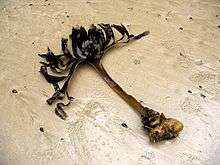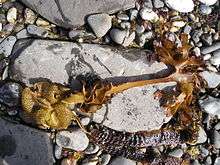Saccorhiza polyschides
Saccorhiza polyschides, common name furbellow, is a large brown algae of the lower shore and is the largest seaweed found in Europe.[2]
| Saccorhiza polyschides | |
|---|---|
 | |
| Scientific classification | |
| Kingdom: | Chromista |
| Phylum: | Ochrophyta |
| Class: | Phaeophyceae |
| Order: | Tilopteridales |
| Family: | Phyllariaceae |
| Genus: | Saccorhiza |
| Species: | S. polyschides |
| Binomial name | |
| Saccorhiza polyschides | |
| Synonyms | |
| |
Description

Saccorhiza polyschides is a large and bulky seaweed growing to 2-2.5 metres long. The holdfast is a large, bulbous[3] hollow, knobbly structure. The stipe is long, tough, leathery and rigid and is several centimetres wide. Near the base the margin forms several broad, wavy frills. These ruffles tend to dissipate wave energy and lessen the likelihood that it will be torn from the rock. The frond is digitate with about eight large flat lobes and may be massive. The lack of a midrib distinguishes it from Alaria esculenta.[4][5] It is an extremely fast growing species, growing annually from the base and becoming fully extended over the course of a few months.[6]
Habitat
Saccorhiza polyschides is found on the lowest part of the shore. It can not tolerate desiccation and may be found in places where it is wetted by spray when uncovered by the retreating tide. It is often found in association with Laminaria hyperborea.[2]
Distribution
Distribution including Europe: Ireland, Britain, Faroes, France, Greece, Helgoland, Isla de Alboran, Italy, Netherlands, Norway, Portugal, Scandinavia and Spain.[7]
References
- Saccorhiza polyschides (Lightfoot) Batters, 1902 World Register of Marine Species, accessed 21 September 2011.
- Furbellows (Saccorhiza polyschides) The Sea Shore, accessed 21 September 2011.
- Lewis, J.R. 1964. The Ecology of Rocky Shores. The English Universities Press Ltd. p.137
- Newton, N. (1931). A Handbook of the British Seaweeds. British Museum, London.
- Dickinson, C. I. (1963). British Seaweeds. The Kew Series, Eyre & Spottiswoods.
- Barrett, J. H. and C. M. Yonge, 1958. Collins Pocket Guide to the Sea Shore. P. 225. Collins, London
- Saccorhiza polyschides (Lightfoot) Batters. Algaebase, accessed 2 February 2010.